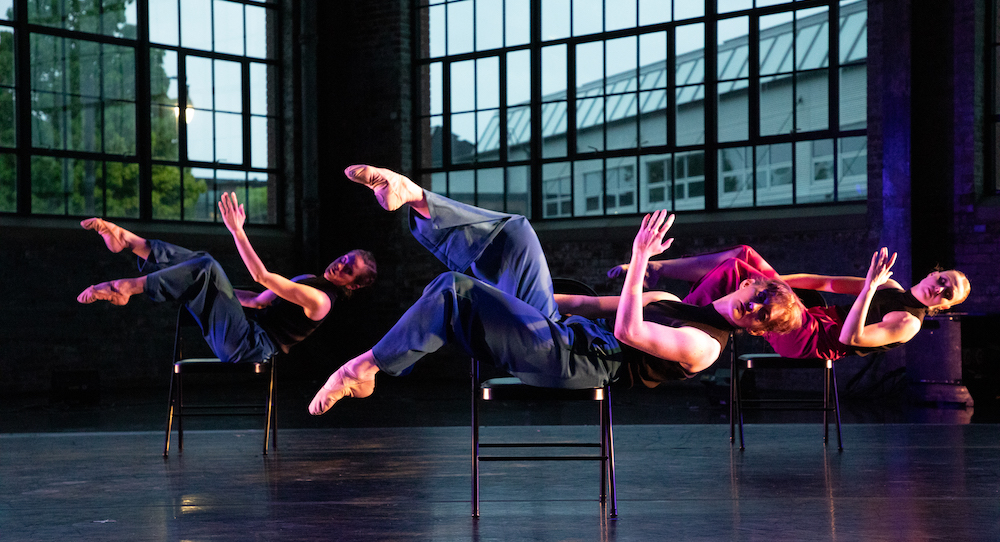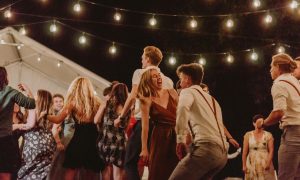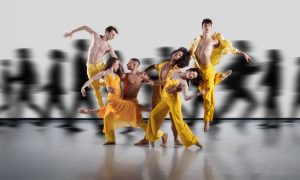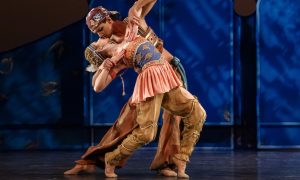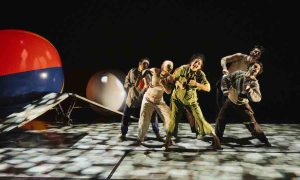WaterFire Arts Center, Providence, RI.
May 18, 2024.
Have you ever watched the Ted Talk Dance vs PowerPoint? The main take-home message: dance can be part of meaningful scientific discovery and innovation, but it doesn’t have to be…the beauty of moving bodies is also enough. That came to mind for me after experiencing Newport Contemporary Ballet’s Frames of Mind.
It was very much grounded in issues of the here and now, and in better understanding them through empirical disciplines. The atmospheric and kinetic beauty at hand alone were also of immense value. Both things can be true.
Executive Artistic Director Danielle Genest spoke to that first point in her pre-show introduction; she noted that the program explores issues of mental health and wellness – which are widespread, and important, discussions these days. She didn’t need to speak to the second part of the above; the command of craft and pure heart reflected in these works were self-evident.
The program was part of the company’s Frontier Series, and the second-to-last in their 2024-2025 Season. The night began with Mark Harootian’s Steady Grip, a tenacious, yet also sensitive movement exploration. Program notes explained how Harootian’s father’s experience with Parkinson’s Disease and Lewy Body Dementia originally inspired the work. How COVID-19 impacted broader mental health and wellness then gave him a broader outlook.
As the pandemic eased, we returned “to a new life” and “[came] to grips with issues that surfaced, such as physical, spiritual, and mental health common to us all, yet rarely spoken of,” Harootian attested. That is poignant – and the ensemble’s emotional investment did it justice. They filled each moment with authentic immediacy.
Staging and movement vocabulary also felt honest to what Harootian had described. Dancers began seated on, and intermittently returned to, folding chairs – underscoring a need for basic support. They were united in that, yet also never truly connected (such as through eye contact or touch): deep and aching isolation. Gasps conveyed a struggle to breathe or find calm.
A memorable gesture, repeated enough to be a motif, embodied a physical tremor. Dancers held their head in one hand, and with the other jerked the bent elbow of that first hand. Their spines swayed, following that motion. Yet, as with the movement quality throughout, there was just the slightest jerkiness: embodied tension.
The work concluded without resolution, without hope rising. There is no known cure for these conditions. Shining a spotlight on them, like this work has, can however confer some degree of sustaining hope.
Then came Memoria Y Vidrio, Rodney Rivera’s passionate moving painting of family relations. “I’m made by memories, especially those of my family,” he affirmed in program notes. It was a moving painting of family relations, through (seemingly) three different families. The work began with three different groupings of three dancers, each in their own color (costumes by Elieen Stoops). Under Stephen Petrilli’s lighting, these three groups interacted in a dim, shadowy atmosphere. Yet light amidst the shadow illuminated moments of lightness and hope.
Each in turn, they dissolved and reformed. Later in the work, they also had their moments in the spotlight – those which illustrated a unique dynamic to each grouping. Rivera’s keen staging, as well as these artists’ stellar theatricality, brought each of those dynamics to vibrant life.
The choreography was especially virtuosic in its intricacy. Unless I looked for that, however, what came across was emotional veracity and kinetic integration. These dancers could move in a way that the effect was primary, the difficulty secondary.
Movement vocabulary was continuous and highly circular; angular gestures did punctuate, yet the flow of momentum continued to spin like a top. That was the beginning of me thinking about cycles. Families continuing or breaking cycles is fairly common parlance in contemporary discourse. This work had me thinking about how dance can be an avenue for investigating, observing, and feeling how that plays out.
The singular dynamic of each grouping also underscored the expanded understanding of “family” in modern life: families by choice, “intentional families”, and other sorts of “non-traditional” family structures.
Short of any or all of that, I could sit back and savor the outstanding artistry playing out in front of me. The ending brought us full circle to the beginning, with the three groupings side-by-side. The cycles may not have broken, yet perhaps understanding had bloomed. That’s a start.
Danielle Genest’s The Lines are Fading closed the program. It’s a poignant and memorable movement examination of brain function, and how it falters as the plaques and tangles of Alzheimer’s Disease spread. As program notes explained, it began with a depiction – through moving bodies – of how neurons fire in a healthy brain. Dancers stood in a line, sharing weight and propelling momentum through limbs and spines.
Their white costumes (design also by Stoops) felt like a blank slate for the infinite possibilities of the human mind (after all, we don’t evenunderstand it all yet!). Some of those possibilities transpired before us as dancers moved out into space and related in various ways. Slowly, but surely and clearly, these connections felt more diffuse.
Genest’s signature movement vocabulary, of a certain raw yet beautifully easeful quality, slowly became more rigid, disconnected. The personas before us in space seemed to increasingly seek connection, yet not have the capacities to find it. Their bearing became more internal, more distant. Petrilli’s lighting of dotted patterns enhanced the mystery and abstraction at hand, not to mention creating some dazzling shadows.
Toward the end, dancers faced and looked intently into the audience – calling us to witness. The lines from the work’s beginning came back again towards the end: a further call to recognize agency, have awareness, and step forward with what we’d experienced. Care also shown through, with dancers lifting and supporting each other’s weight. Rhythmic layering pointed to the challenges and complexity that often come with that care.
The structural arc that Genest had created felt both complex and accessible – and exemplary for what such an arc can be in a work of dance art. Part of me thought that the work could have built the same arc in a shorter duration. On the other hand, then it wouldn’t be able to breathe and resonate as it did.
To introduce the work, Genest spoke a bit to the theme. She then invited up a community partner: Judith Davis, an Ambassador/Spokesperson for Alzheimer’s Association’s Rhode Island Chapter. Davis lives with Alzheimer’s Disease. In the face of that, she is doing all that she can to live each moment to the fullest: engaging with her local community, creating art, and earnestly shifting perspective to the positive.
“Watching this work, I felt like the marbles that have fallen out of my brain…it’s like someone gathered them up and put them back in!” she shared with the audience, full of excitement and fascination. She and Genest embraced, and the audience erupted in applause. This is dance art deeply engaged with its surrounding community, not to mention issues that impact communities worldwide – and in so doing enhancing lives.
That is good for communities and good for dance. The art, in and of itself, also has tremendous worth. It doesn’t have to be an “either-or”…it’s a “both-and.” Newport Contemporary Ballet’s Frames of Mind has shown us what that “both-and” can look like. I can’t wait to see what further iterations of that may lay in store.
By Kathryn Boland of Dance Informa.


